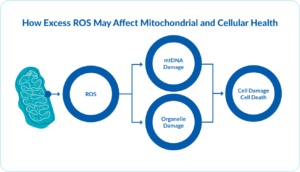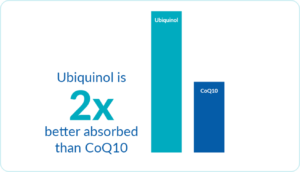The world’s population is aging due to an upwards shift in life expectancies and a downward shift in birth rates.1 Yet, while advancements in healthcare have extended lifespans, evidence indicates that the additional years are not always as healthy as they could be. In fact, many people entering their later years are faced with reduced physical function and increased susceptibility to chronic health conditions.2
Paradoxically, modern prolonged lifespans often coexist with lifestyle factors that can accelerate cellular aging and contribute to common health conditions associated with oxidative stress. Diets high in saturated fats, added sugars, and processed foods, as well as chronic stress, physical inactivity, insufficient sleep, smoking, and excessive alcohol consumption, have been linked to oxidative damage at the cellular level. Exposure to environmental pollutants, toxins, and UV radiation can further impact cellular health, which ultimately affects the whole body.
The growing gap between lifespan and quality of health emphasizes the need for lifestyle wellness programs that focus on healthy behaviors and lifestyle choices. Eating a balanced diet, engaging in regular physical activity, and refraining from tobacco use can all support wellness and help maintain physical and cognitive health in our aging populations.
In this context, maintaining a healthy antioxidant/oxidative balance in the body is a key factor in protecting cells from free radical damage that, left unchecked, leads to oxidative stress. Antioxidants consumed through a healthy diet and taken in the form of supplements can reduce oxidative stress and support physiological processes essential for overall wellness.
In this blog, we will examine the mechanisms of oxidative stress and how free radicals disrupt cellular processes. We will highlight the role of ubiquinol, the active antioxidant form of coenzyme Q10 (CoQ10), in supporting healthy aging by promoting mitochondrial function, cardiovascular health, and, for women, general health and well-being during the menopausal years.

The Relationship Between Oxidative Stress, Cellular Function, and Age-Related Decline
Mitochondria, the powerhouses of the cell, generate most of the energy required for cellular activities, turning nutrients into energy via the electron transport chain (ETC). However, some electrons escape the ETC and react with oxygen, forming reactive oxygen species (ROS), which are a kind of free radical. These unstable molecules seek stability by pilfering electrons from healthy cells. As these seemingly minor thefts accumulate over time, they can ultimately lead to cellular damage. Antioxidants counteract this process by donating electrons, effectively neutralizing ROS and preventing further oxidative damage to cells.
Oxidative stress occurs when the body’s antioxidant defenses are overwhelmed by ROS production. This imbalance is exacerbated by unhealthy lifestyle choices, exposure to external pollutants, and the natural decline in the body’s antioxidant capacity and internal repair mechanisms that come with aging. Excess ROS can have a destructive influence on cell components, damaging lipids, proteins, and DNA, ultimately impairing cell structure and function.3,4
The mitochondria are susceptible to the same damage as the cell. Oxidative damage to the mitochondria can cause inefficiencies in energy production and the release of more free radicals. This cycle of destruction can also impact vital mitochondrial functions beyond energy production.5 Mitochondria initiate cellular repair, including apoptosis (programmed cell death), to remove damaged cells and prevent that damage from proliferating. Mitochondria also manage cell homeostasis via fission and fusion and regulate the expression of specific genes, such as those involved in immune responses.6-8 Over time, the cumulative impact of oxidative stress on these essential functions contributes to further mitochondrial and cellular damage, which is linked to age-related functional decline.9

Ubiquinol as a Cornerstone of Antioxidant Defense
Ubiquinol and ubiquinone are two forms of CoQ10, a lipid-soluble molecule produced naturally in the body. Ubiquinol, the active antioxidant form of CoQ10, plays a critical role in the production of cellular energy and supports mitochondrial function and cellular health. Ubiquinol and ubiquinone are found in every cell of the body and are required for 95% of cellular energy production, providing the heart, lungs, and other organs with the energy necessary to function at optimal levels.10 Within the ETC, there is a constant switching back and forth between these two forms of CoQ10.
Combating oxidative stress requires balancing antioxidants and ROS. Ubiquinol is the only lipid-soluble antioxidant synthesized in the body, enabling it to penetrate the double-lipid membrane of the mitochondria, where most ROS are formed. Moreover, it has two electrons to donate to ROS, whereas many other antioxidants only have one. These two properties make ubiquinol a powerful antioxidant well-suited to keeping ROS in check where they are formed and helping mitigate the potential cascade of oxidative damage.
In addition to its action within cells, ubiquinol has an essential antioxidant function in the blood. Its lipid solubility allows it to bind with lipid-based low-density lipoprotein cholesterol (LDL), which is particularly susceptible to oxidation. The close proximity of ubiquinol to LDL allows it to protect the particle from oxidation, supporting vascular health.11,12
With aging, there is an increase in ROS and a decrease in the body’s cellular repair mechanisms, concurrent with a decreased ability to convert ubiquinone into ubiquinol, which can result in reduced ubiquinol levels at a time when the body needs ubiquinol even more. This is where supplementation with Kaneka Ubiquinol® emerges as an ally for lifestyle wellness programs, particularly for aging adults.
Backed by more than 85 human clinical studies using Kaneka Ubiquinol® and 50 years of combined CoQ10 (ubiquinol and ubiquinone) research and testing, Kaneka Ubiquinol® is bioidentical to the ubiquinol naturally produced in our bodies. Its enhanced absorption and bioavailability make Kaneka Ubiquinol® a better choice than conventional CoQ10 (ubiquinone) supplements for adults in their 40s and beyond.

Kaneka Ubiquinol® has been shown to be two times better absorbed than conventional CoQ10 and doesn’t require any conversion to perform its antioxidant functions.13 In a clinical study, healthy adults taking 200 mg of Kaneka Ubiquinol® daily for 30 days showed an increase in blood ubiquinol levels of approximately eight times compared to their baseline levels.14
Supporting Healthy Aging
Ubiquinol protects against oxidative stress, which, over time, can lead to premature aging and age-related functional decline. Supplementation with Kaneka Ubiquinol® has been shown in clinical studies to support the body’s antioxidant capacity and promote a healthy ubiquinol/CoQ10 balance in the blood that is supportive of cardiovascular health.12,15 Clinical studies have demonstrated a correlation between total CoQ10 status and the percentage of ubiquinol in plasma and overall physical functioning and muscle health in older adults.16,17
For women, Kaneka Ubiquinol® has also been shown to support general health and well-being during and after menopause.18,19 In a consumer use study, 80% of postmenopausal women taking 200 mg of Kaneka Ubiquinol® per day reported decreased irritability, sensitivity, stress, and mood swings after 60 days of supplementation.18

Promoting Cardiovascular Health
Studies have shown that Kaneka Ubiquinol® improves blood ubiquinol levels and positively affects other markers associated with cardiovascular health.12,20-23 Ubiquinol promotes cardiovascular wellness by:
- Supporting the high-energy requirements of the heart24
- Replenishing CoQ10 blood levels depleted by statin cholesterol medicines25
- Promoting improved vasodilation12
- Supporting nitric oxide production12
- Protecting against the oxidation of LDL cholesterol12,26
- Protecting the integrity of mitochondrial function15,27
- Supporting healthy levels of GGT, NT-proBNP and CRP, markers of cardiovascular health20-23
Enhance Your Health Supplement Offerings With Kaneka Ubiquinol®
Kaneka Ubiquinol® enhances cellular energy production and protects against cellular and mitochondrial damage caused by free radicals, which may increase with age. It has a well-established safety profile, as demonstrated by extensive clinical trial data.
As a trusted leader in ubiquinol production in the United States, Kaneka Nutrients ensures the quality, reliability, and purity of our ingredients, delivering the safety and efficacy necessary to enhance your premium product formulations.
Kaneka Ubiquinol® is available from Kaneka Nutrients to supplement manufacturers and healthcare providers as a pure crystalline powder for use in softgels, liquid capsules, and other light- and oxygen-controlled environments. Partner with Kaneka Nutrients for unmatched excellence in ubiquinol supplementation.
Related Posts
NutraIngredients – Apr 5, 2024
Nutraceuticals World - Sep 16, 2024
SupplySide Supplement Journal - Sep 20, 2024


